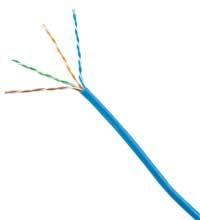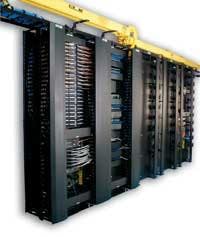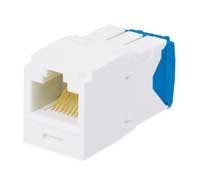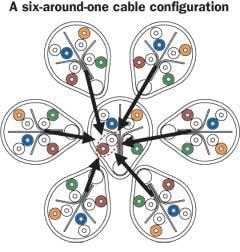There is significant new technology behind the latest UTP solutions.
Is it really possible for a network to transmit 10 gigabits of data per second over traditional copper cable?
One would think such a high-speed data rate is strictly reserved for high-end singlemode and multimode fiber; however, a group of leading manufacturers have been hard at work for the last two years in the Institute of Electrical and Electronics Engineers (IEEE; www.ieee.org) 802.3an task force, trying to determine the technical feasibility of achieving 10GBase-T performance. Based on preliminary testing of new structured cabling designs and anticipated advancements in semiconductor technology, the task force has conclusively determined that 10-Gigabit Ethernet performance over copper will be a reality in the very near future.
This emerging technology requires a partnership between semiconductor chip and structured cabling manufacturers. On one hand, new semiconductor chips will have to be developed to support a new line-encoding scheme to further suppress internal cable noise through the use of digital signal processing (DSP) technology. On the other hand, copper cable and connectivity will have to be redesigned to support transmissions at very high frequency levels to increase channel bandwidth. In the end, this combination of advanced technologies will deliver a cost-effective media for the enterprise organizations’ most demanding network applications.
Market drivers for 10GBase-T
While the development of a 10GBase-T system may be exciting from a technology perspective, one may wonder what will be the market applications for this new solution, given most workstations today operate on either 10 or 100Base-T systems. But today’s network infrastructures are being redefined to increase enterprise productivity, address soaring storage requirements, support convergence, and to provide complete security to vital business information. It is anticipated that key users of this emerging technology will be data centers, high-end workstations, and Web-enabling applications.
More than ever, information technology is playing a critical role in the success and profitability of businesses. To gain a competitive edge, many organizations are using data centers to increase the speed, efficiency, and security of their network. It is now common to see the deployment of computer cluster farms, storage area networks (SANs), and disaster-recovery storage devices in data centers within a network system.
Today, many applications run on multimode fiber channels to ensure they operate effectively as well as have enough bandwidth for future growth. With the introduction of 10GBase-T copper systems, end users will have more options when they deploy their structured cabling system in a data center.
Software engineers continually work on new bandwidth-intensive computer applications that can be run to improve business output or enhance customer service. Current applications include telemedicine, real-time video/audio broadcasting over the Web, digital videoconferencing, and streaming video. Likewise, the size and complexity of data files between high-end workstations is increasing rapidly. The transfer of medical imagery files, the use of 3-D scientific modeling techniques, and the deployment of special media rendering tools are already beginning to seriously stress some enterprise networks.
One can be assured that, with the constant development of new Web-enabling technologies, data rates throughout the entire enterprise network will increase with time. Fortunately, the new 10GBase-T copper cabling system will provide end-users with a cost-effective media for today’s and tomorrow’s most demanding bandwidth applications.
Standards to support 10GBase-T
Given the anticipated marketability of a 10GBase-T cabling system, IEEE has been working under the 802.3an task force on the development of physical layer (PHY) and media access control (MAC) layer requirements to support 10-Gbit/sec Ethernet performance. In October 2004, a milestone was reached when the task force published the first draft 10GBase-T standard, which specified the following key requirements:
1. Full-duplex baseband transmission over all four twisted pairs;
2. Transmission data rates of 2.5 Gbits/sec over each of the four twisted pairs;
3. New line-encoding schemes of PAM-12 (pulse amplitude modulation);
4. Preservation of the 802.3/Ethernet frame format at the MAC client service interface (to ensure interoperability).
Using a line-encoding scheme of PAM-12 requires less bandwidth (500 MHz) than other line-encoding scheme options reviewed by the IEEE. The development of this new line-encoding scheme is one of the key components of making 10GBase-T a reality, because it significantly reduces the bandwidth requirements on the structured cabling system.
The draft standard also specifies the channel electrical requirements for structured cabling systems to ensure the necessary channel bandwidth, and bit-error-rate is maintained to support 10-Gbit/sec transmission rates.
Following are the key specifications:
• Complying with ISO 11801 Class F/Category 7 insertion loss requirements to ensure the proper signal strength down the entire length of the channel;
• Suppressing power-sum alien crosstalk (PSNEXT) up to 500 MHz to reduce the random signal coupling between pairs of neighboring cables;
• Extending the ISO 11801 Class E/Category 6 electrical parameters of near-end crosstalk (NEXT), power-sum NEXT, equal-level far-end crosstalk (ELFEXT), power-sum ELFEXT, and return loss up to 500 MHz to complement the internal noise suppression achieved through DSP technology.
With all of the new requirements working hand-in-hand -new line-encoding scheme, DSP technology, and channel electrical specifications up to 500 MHz-the draft standard will support 10-Gbit/sec transmission rates over a four-connector channel using twisted-pair copper cabling over the following distances:
• At least 100 meters on a ISO 11801 Class F/Category 7 shielded copper cabling system;
• At least 55 meters on a ISO 11801 Class E/Category 6 UTP copper cabling system (current Category 6-compliant solutions);
• Up to 100 meters on a ISO 11801 Class E/Category 6 augmented UTP copper cabling system
The new ISO 11801 Class E/Category 6 augmented UTP copper cabling system is expected to achieve the greatest market acceptance because it does not require special bonding and ground installation procedures, nor does it impose short-distance limitations on channel runs.
IEEE has taken a leadership role in laying the foundation for development of the 10GBase-T standard. TIA/EIA and ISO/IEC have also been actively developing documents for a 10GBase-T standard. While IEEE has established the electrical channel specifications for structured cabling systems, which for the most part have been incorporated into TIA/EIA and ISO/IEC 11801 working documents, the majority of the IEEE standard will be directed toward developing the line-encoding scheme and DSP requirements for semiconductor chip manufacturers. TIA/EIA and ISO/IEC 11801 will be the standards bodies that ultimately specify all of the requirements for structured cabling systems. These two standards bodies are currently working on the component requirements to ensure interoperability, and gain agreement on test parameters and procedures to support 10GBase-T performance. All three standards bodies-IEEE, TIA/EIA, and ISO/IEC 11801-are expected to have a fully ratified and published 10GBase-T standard by the middle of 2006.
When IEEE established the channel electrical specifications in the October 2004 draft 10GBase-T standard, it set in motion the development of new technology to make 10-Gigabit Ethernet performance a reality in the very near future. Structured cabling vendors have clear channel specifications that must be met up to 500 MHz. Semiconductor vendors also understand how their new chips must be designed to augment the channel performance to achieve a 10-Gbit/sec transmission rate.
For structured cabling vendors developing a UTP copper cabling system to support 10GBase-T performance in a four-connector, 100-meter channel, the most difficult technology challenge is suppressing PSANEXT up to 500 MHz. PSANEXT is the aggregation of unwanted signal coupling of crosstalk noise at the near end from pairs in a neighboring cable onto an affected pair of a cable. Some of the fundamental ways to reduce PSANEXT in a channel are:
• Increasing the distance between the noise source and the affected cable pair. This can readily be achieved by increasing the diameter of the copper cable; however, at some point the cable gets too large from a cable-management perspective and/or too costly to manufacture.
• Reducing the twist length and improving the consistency of the twist rate down the length of the cable to make the electrical transmission throughout the channel more balanced, which in turn makes the channel more immune to external noise. Achieving a balanced transmission is determined by both the design and the quality control used to manufacture the cable.
Besides suppressing ANEXT, the other significant technology challenge is extending the existing Category 6 electrical parameters up to 500 MHz. Some of the fundamental design specifications are:
1. Improve compensation techniques in the connectors to improve NEXT performance between 250 and 500 MHz;
2. Improve connector termination methods to reduce variability between terminations by reducing the untwisting of the copper wire conductors and controlling the conductors during termination;
3. Improve return loss of the components to improve channel performance in the high frequencies;
4. Have highly concentric insulation to conductor diameters to improve return loss and insertion-loss performance;
5. Increase the copper conductor’s diamter to improve the signal strength throughout the channel.
Technology challenges
For semiconductor chip vendors, the two key technology challenges to support 10GBase-T performance are developing a new line-encoding scheme and enhancing the performance of DSP technology. As you increase the number of levels of PAM-in this case, there are 12-the more complicated the semiconductor chip’s design and the more sensitive the channel signal-to-noise. The IEEE 802.3an task force has determined that PAM-12 is the optimal line-encoding scheme to support 10-Gigabit Ethernet performance.
The other technology that needs to be built into the new semiconductor chip is DSP, to suppress internal cable channel noise. By sending an electronic signal down an individual channel, DSP technology, through the use of algorithms, can predict and filter the effects of reflected signals (return loss), NEXT, and ELFEXT. As the frequency level within a channel increases, as is the case with 10GBase-T transmission up to 500 MHz, the amount of internal noise increases in size and complexity. So, DSP technology and the associated algorithms become more difficult to design.
While DSP technology is effective at reducing internal cabling-system noise, it has limited ability to cancel external noise, in the form of PSANEXT, because it is random and unpredictable. Hence, the burden is on the structured cabling system to suppress PSANEXT. In summary, with all of the components in place, 10-Gigabit Ethernet performance over twisted-pair cabling can become a reality with:
• PAM-12 line-encoding scheme to reduce overall bandwidth requirements on the channel to approximately 500 MHz;
• DSP technology to further reduce internal noise and expand the usable internal channel bandwidth beyond 500 MHz;
• ISO 11801 Class F/Category 7 insertion loss to ensure adequate signal strength for a 100-meter channel;
• Extending Cat 6 electrical parameters up to 500 MHz;
• Reduced PSANEXT in the structured cabling up to 500 MHz.
Testing procedures
Many structured cabling vendors have recently introduced UTP cabling systems that claim to support 10-Gbit/sec data rates in a 100-meter channel. But how does an end user know if the cabling system they have purchased can really support 10GBase-T performance?
Fortunately, handheld tester manufacturers are introducing software upgrades that can measure Category 6 electrical parameters up to 500 MHz. While these testers let end users measure internal noise, there is not an easy way to measure PSANEXT in the field. To properly measure PSANEXT, a six-around-one cable configuration must be tested.
All six cables must be energized to accurately measure the effects of external noise on the disturbed cable. In an actual end-user installation, it would be nearly impossible to determine which six channels ought to be energized due to the intermingling and randomness of all of the cables in the network’s wire-management pathways. Therefore, proper testing of PSANEXT can only be conducted in a lab where a true six-around-one cable configuration can be tested with a network analyzer.
End users will have to rely largely on the structured cabling vendors’ reputation, guaranteed warranty claims, and any third-party verification of the system’s performance levels. In addition, end users can look for a structured cabling vendor that offers a true end-to-end system, not just a new cable or single connectivity component. All components in a 10-Gigabit Ethernet system are important. Jack modules, copper cable, patch panels, and patch cords, for example, all must be precisely tuned to achieve 10-Gigabit speeds.
The next advance
Ethernet is the most widely used LAN communication architecture. Working together, new semiconductor chips and new end-to-end structured cabling systems will deliver the next advance in technology by providing reliable 10-Gigabit Ethernet performance over copper. This emerging technology will soon provide end users with a cost-effective medium for the highest-bandwidth requirements of today and tomorrow.
PHIL CHANDLER is a business development manager at Panduit Corp., which is an active member of the IEEE 802.3an task force and has designed a complete 10-Gigabit Ethernet system (www.panduit.com/syn08).




